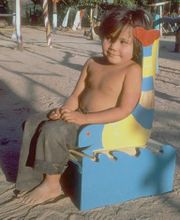Hesperian Health Guides
Sitting Aids
A wide variety of early sitting aids are included in the chapter on cerebral palsy. Special seating adaptations for chairs and wheelchairs are in Chapter 65. Here we include a few more ideas:


seat for child with spasticity who has knock-knee contractures (one of many possibilities)
strap for keeping legs apart (one around each leg and tied through holes in sides and seat)
holes for straps
 |
tire seat or swing bends head, body, and shoulders forward to help control spasticity. | |
| A log or roll seat helps the child who has spasticity or difficulty with balance sit more securely with legs apart. Log should be as high as the knees. Leave a little room between the cut-out circle in the table and the child’s belly. |  |
|
 |
seat for a child with spasticity whose body stiffens backward | |
Design from Handling the Young Cerebral Palsied Child at Home.
OTHER IDEAS FOR HOLDING LEGS APART
From Don Caston and Healthlink Worldwide
 | ||
| from other parts of this book | ||
 | ||
| "Maricela's Story" |
"A “Playground for All” Built by Children — Projimo, Mexico" |
|
 | |||
| "Prevention and Early Management of Contractures" | "How Can We Help?" | "Deciding Where to Place Body Guides" | "Self-Feeding Suggestions for the Child with Cerebral Palsy" |
 |
 |
| A seat and table like this in the form of a fish on the ocean makes sitting in a special seat fun. So do the village-made toys (PROJIMO, seat design by Don Caston). | The seat can be used for straight leg sitting, or put on top of the table for bent-knee sitting. Other designs include “squirrel” seats on “tree” tables. |
This page was updated:19 Apr 2025


